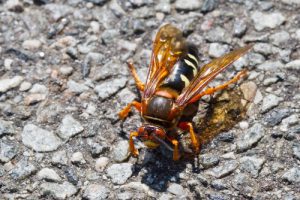Cicada Killer Wasps Are Really Just “PussyCats!”
By Chris Williams on August 16, 2012.
The name makes them sound like bad dudes — “Cicada Killers.” You have to figure that any wasp that can kill a cicada is pretty scary. And these are big, intimidating wasps. The larger female can be up to two inches long! That wasp must be mean and aggressive with a really bad sting. Not so, cicada killers are gentle giants, sort of the Shreks of the wasp world.
The author of a very extensive website, Massachusetts Cicadas (www.masscic.org), stresses how docile these wasps really are. He says he has never known anyone to be stung by a cicada killer wasp. I have laid down on my stomach in the middle of a (group of cicadas) to film a cicada killer female digging a burrow. They were flying all around me and I was never attacked. I have even handled male and female wasps with my hand and I was never stung. However, I wouldn’t suggest you sit on one or try to crush one with your hand because then they may sting. Actually, even if you do sit on one, you have only about a 50% chance of getting stung because only the female wasps have stingers.
 Cicada killer wasps are only around for a few weeks, the same time that cicadas are around. Cicadas are their only prey but the wasps don’t actually feed on cicadas. They capture them to feed to their larvae; adults feed on nectar. Cicada killer wasps don’t actually kill cicadas either, at least not directly. The female paralyzes the captured cicada with her sting, maneuvers it into her ground burrow, then lays an egg on the immobile cicada. One female wasp can capture as many as 16 cicadas to provision her burrows. When her egg hatches, the larva has an instant feast. The larva feeds on the cicada which doesn’t rot during this time because it is actually still alive. When the larva has completed its development, it pupates in the burrow, then digs upward and emerges the following July as a flying cicada killer wasp.
Cicada killer wasps are only around for a few weeks, the same time that cicadas are around. Cicadas are their only prey but the wasps don’t actually feed on cicadas. They capture them to feed to their larvae; adults feed on nectar. Cicada killer wasps don’t actually kill cicadas either, at least not directly. The female paralyzes the captured cicada with her sting, maneuvers it into her ground burrow, then lays an egg on the immobile cicada. One female wasp can capture as many as 16 cicadas to provision her burrows. When her egg hatches, the larva has an instant feast. The larva feeds on the cicada which doesn’t rot during this time because it is actually still alive. When the larva has completed its development, it pupates in the burrow, then digs upward and emerges the following July as a flying cicada killer wasp.
Several cicada killers may nest in the same area but they do not have colonies like yellowjackets. Instead, each cicada killer female digs her own conspicuous burrow, leaving piles of excavated soil next to the hole. A female’s underground burrow can have many chambers branching off of the main entrance. Preferred burrow nest sites are large, sunny open areas with sandy soil and with tall trees nearby (where cicada larvae have emerged).
If you just can’t live peacefully with cicada killers for the brief time that they are around, or if they’re nesting in an area where your kids play, you may want to have a pest control company treat the site. To keep them from nesting in the same area next year, try to eliminate areas of bare soil where they like to nest by planting grass or other plant